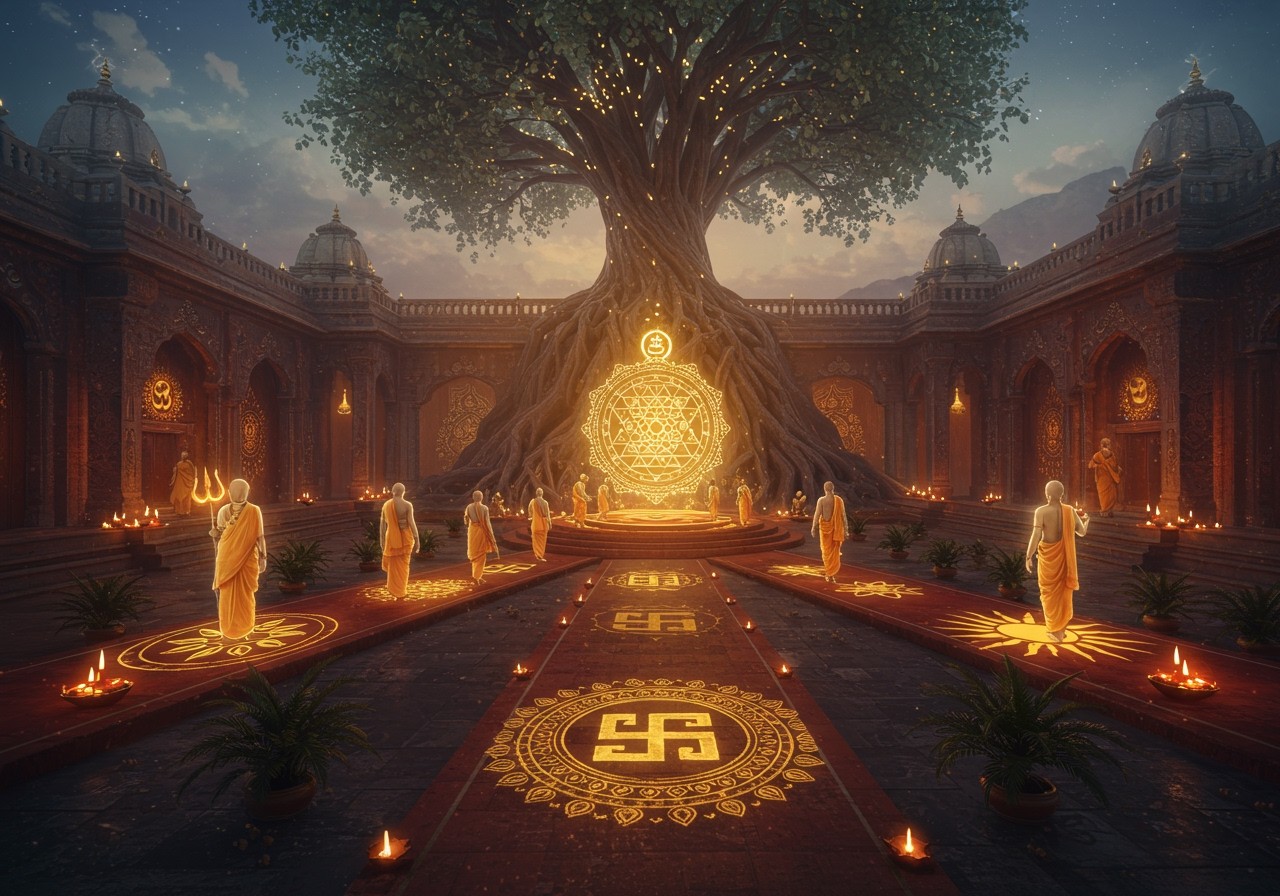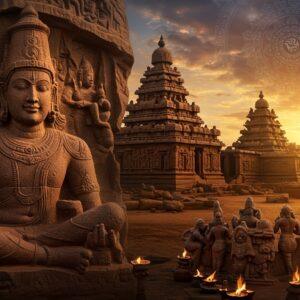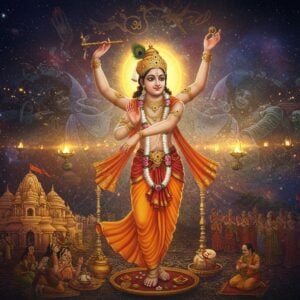Exploring Hindu Sampradayas: A 2025 Guide to Hindu Traditions

Hindu Sampradayas are a vital aspect of Hindu traditions, having developed over millennia. They represent diverse spiritual paths, each with its own unique philosophies and practices. These traditions play a significant role in the lives of many Indians today, who seek authentic spiritual experiences while staying connected to their roots. For those seeking to deepen their understanding of Hindu rituals, Poojn.in (https://www.poojn.in/post/14887/hindu-rituals-significance-and-importance-2) provides valuable insights.
Understanding Sampradaya
Sampradaya refers to a spiritual lineage or tradition within Hinduism, passed down through generations. It acts as a conduit for preserving religious teachings and cultural heritage. The guru-disciple relationship (guru-shishya parampara) is paramount in maintaining the integrity of a Sampradaya. These traditions contribute to the rich tapestry of Hindu practices and adapt to changing times while upholding core principles. They influence both individual spiritual journeys and community religious observance. Discover more about Hinduism’s core beliefs and practices at Poojn.in (https://www.poojn.in/post/14874/exploring-hinduism-core-beliefs-and-practices-2).
Major Sampradayas in Hinduism
Several prominent Sampradayas shape Hinduism’s diverse landscape:
- Vaishnavism: This tradition centers on the worship of Lord Vishnu and his incarnations (avatars) like Rama and Krishna. It emphasizes devotion (bhakti) as a path to liberation (moksha). Devotees often engage in chanting, singing devotional songs, and temple worship. Learn more about Hindu Gods and Goddesses at Poojn.in (https://www.poojn.in/post/14877/hindu-gods-and-goddesses-a-complete-guide-2).
- Shaivism: This tradition focuses on the worship of Lord Shiva, often seen as the destroyer and transformer. It encompasses a range of practices, from ascetic renunciation to devotional temple worship. Shaivism has distinct rituals and philosophical teachings. Those interested in exploring Hindu temples can find a helpful guide at Poojn.in (https://www.poojn.in/post/14882/hindu-temples-explained-a-guide-to-their-significance-2).
- Shaktism: This tradition venerates the Divine Mother (Devi or Shakti), the primordial cosmic energy. Followers believe that the feminine principle is the ultimate source of creation and power. This Goddess manifests in various forms, including Parvati, Durga, and Kali. Each form embodies specific qualities and energies.
- Smartism: This tradition worships the Supreme in one of six forms: Ganesha, Shiva, Shakti, Vishnu, Surya, and Skanda. It emphasizes the unity of the divine and allows for personal choice in worship. Smartism is known for its philosophical and intellectual approach. Expand your knowledge of the sacred texts of Hinduism at Poojn.in (https://www.poojn.in/post/14891/sacred-texts-of-hinduism-a-guide-to-key-scriptures-2).
Regional variations further enrich these primary traditions, adding layers of cultural nuance and diversity. Delve into the concepts of Dharma and Karma in Hinduism with Poojn.in’s insightful resource (https://www.poojn.in/post/14900/dharma-and-karma-in-hinduism-explained-2).
Regional and Cultural Influences
Geography and culture significantly shape the distinct identities and practices of various Sampradayas. Local languages, artistic expressions, and customs heavily influence religious rituals and festivals. Local deities and folklore often become integrated into broader traditions, creating a rich tapestry of regional variations. Migration has led to the global spread of Sampradayas, further enriching practices through cross-cultural exchanges. Preserving this heritage in an increasingly globalized world presents both challenges and opportunities. Explore the global reach of Hinduism and its diverse traditions at Poojn.in (https://www.poojn.in/post/14921/hinduisms-global-reach-a-look-at-its-diverse-traditions-2).
Modern Adaptations and Innovations
In the 21st century, Hindu Sampradayas continue to adapt to societal changes and technological advancements. Digital platforms play a growing role in religious education, community building, and even the performance of rituals. Engaging younger generations is crucial for the continued relevance and vitality of these traditions. Many Sampradaya-based organizations are actively involved in social welfare initiatives and interfaith dialogue, demonstrating their commitment to contemporary issues. Balancing the preservation of tradition with thoughtful innovation is essential for maintaining their integrity and continued relevance. Learn more about the history and origin of Hinduism at Poojn.in (https://www.poojn.in/post/14924/hinduism-a-complete-history-and-origin-2 and https://www.poojn.in/post/14932/hinduism-a-concise-history-and-exploration-of-its-origins-2).
Importance in Personal and Community Life
Sampradayas provide a sense of identity and belonging to individuals and communities. They offer guidance for personal spiritual growth and ethical living, promoting values such as compassion, non-violence, and selfless service. Community involvement provides essential support systems, offering spiritual guidance, social networks, and opportunities for collective worship. Festivals and rituals serve as powerful expressions of collective faith and unity, reinforcing social bonds within the community. Sampradayas play a vital role in preserving cultural heritage and transmitting values across generations, even amidst the challenges of increasingly diverse societies. Consider enhancing your personal altar with authentic Laddu Gopal statues from Poojn.in (https://www.poojn.in/product/9352/laddoo-gopal-astadhatu-brass-laddu-gopal-murti-laddu-gopal-pure-pital-brass-laddoo-gopal-to-worship-with-all-your-heart).
Additional Insights into Denominations
As of 2025, scholarly understanding of Hindu denominations highlights the following:
- Vaishnavism: With an estimated 399 million followers, Vaishnavism reveres Vishnu as the supreme God, including his incarnations (avatars) like Krishna and Rama.
- Shaivism: Followed by approximately 385 million, Shaivism focuses on Shiva as the supreme deity, often characterized by mystical and meditative practices predominantly in South India.
- Shaktism: Embraced by around 305 million, Shaktism worships Shakti (Devi) as the supreme divine mother, manifesting in various forms like Parvati, Durga, and Kali.
- Smartism: Adhered to by roughly 5% of Hindus, Smartism offers a liberal approach, allowing the worship of the supreme in different forms like Ganesha, Shiva, Shakti, Vishnu, Surya, and Skanda.
- Other Denominations: Some sources also note other denominations like Suryaism/Saurism (Sun God), Ganapatism (Ganesha), Kaumaram (Lord Kartikeya), Dattatreya Sampradaya (Dattatreya), and the Ramanandi Sampradaya (a Vaishnava group). Light up your spiritual practices with high-quality agarbatti and dhoop from Poojn.in (https://www.poojn.in/product/12105/kushal-mangal-sandalwood-puja-prayer-agarbatti-incense-stics-liberty-pack-of-6-box-100-gm-each).
Frequently Asked Questions about Sampradayas
What is a Sampradaya in Hinduism? A Sampradaya acts as a distinct lineage or school of thought within Hinduism, guiding devotees on specific paths of worship, rituals, and philosophical understanding.
How many Sampradayas are there in Hinduism? Hinduism traditionally recognizes four primary Sampradayas: Vaishnavism, Shaivism, Shaktism, and Smartism, each with unique beliefs and practices. It’s important to note that the categorization of Sampradayas can be complex and may vary depending on the source.
How many Sampradayas are in Sanatan Dharma? Sanatan Dharma, often considered synonymous with Hinduism, encompasses the same four main Sampradayas mentioned above. The term “Sanatan Dharma” emphasizes the eternal nature of the religious principles.
What are the key differences between the Sampradayas? The primary distinctions between Sampradayas lie in their chosen deity or deities of worship, the associated philosophical interpretations of scriptures, and the specific rituals and practices they follow. For example, Vaishnavas focus on Vishnu and his avatars, while Shaivas center their worship on Shiva.
Why do Hindus follow different Sampradayas? Hindus follow different Sampradayas based on family traditions, personal preferences, and the resonance they feel with specific deities and philosophies. The diversity within Hinduism allows individuals to connect with the divine in ways that are personally meaningful.
Can a person follow more than one Sampradaya? While most Hindus primarily adhere to a single Sampradaya, some individuals incorporate practices from multiple traditions, often reflecting a broader understanding or a personal syncretic approach to Hinduism.
How can I learn more about a specific Sampradaya? You can delve deeper into a particular Sampradaya by studying their scriptures, participating in their specific rituals and temple services, or seeking guidance from gurus or knowledgeable individuals within that tradition. This can involve attending discourses, reading commentaries, and engaging in personal reflection.


